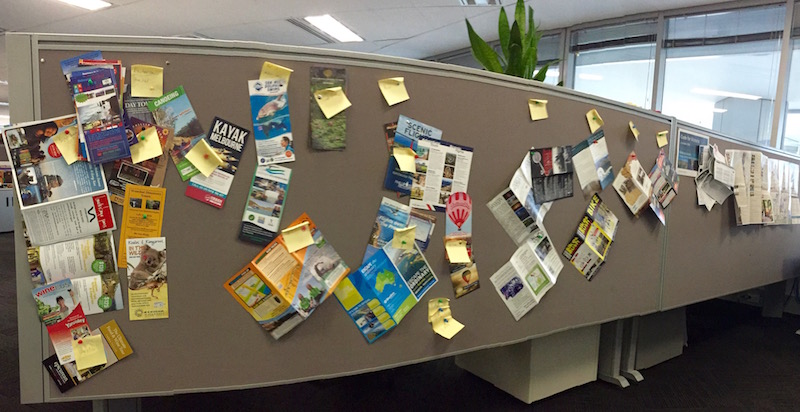
Marc, in our Bairnsdale user research, stated a key issue in conservation.
But how do we achieve this? Although the taxpayer should, and does pay for the victorian biodiversity atlas, any other systems need to be financially viable. One of the areas where money is spent is tourism. Many tourists have interests in biodiversity and they may be used to finance better biodiversity data collection. So what if we made a tourism directory that helps tourists find their way and collect information?
The opportunity in tourism is that it is a cash industry, and a successful business that manages to collect information may not be reliant on government grants. However, collecting money from tourists is a challenge in itself. Tourism information is generally free because operators advertise to them. Yet some tourists may be willing to pay for specific information. We could also sell products to companies. Yet biodiversity data collection is not necessarily central to tourism business success. Either advertising or direct sales as a method to differentiate the product from others may be useful.
I thought a good place to start thinking about this is a tourist information centre. So I went to federation square. There is a tourist information centre there that serves a large number of tourists as possibly one of the first ports of call in the city.
I talked to one of the volunteers who took me to tourism brochures, which I collected and collated later. These tourism brochures are a valuable resource to consider the types and size of various tourism markets.

| Tourism Category | Opportunity for Biodiversity | Economic Opportunities |
|---|---|---|
| Sightseeing | Many tours go to the same places on the great ocean road for instance and may interact with many species | This is potentially the largest segment in number of tourists and operations. The operations may want to differentiate themselves, thus buy hardware and applications. The tourists themselves may be interested in a mobile app as a guide to things other people have seen at the same location. |
| Gastronomic Sightseers | These tours will go to a vineyard or restaurants in the countryside. These are usually controlled, non wild areas but migratory species may move through them and threats | Vineyards may have tours through their grapes. Applications that track wildlife could be involved in green labelling and marketing of the wine. Information, audio guides, and visualisations of the ecological significance of conservation work done on the property may be sold as a guide. |
| Wildlife Tours | These tours go where a certain species will be predictably seen but other sightings may be made. They may be on public or private land influencing the degree to which installed observation equipment may be placed. | There were only a few wildlife tours advertised. Similar tools to sightseeing may be used. Perhaps installations which increase interactivity could be created. |
| Aerial Tours | Both helicopters and fixed wings provide scenic tours. From the air, it is possible to take photos of vegetation and of large fauna such as whales, and maybe some large land mammals. Pilots also collect some data, including strange sightings in their flight records. | A pilot may see some sort of eco-certification process as a way to attract the least price sensitive customers. Photos, video, or an atlas of information about the information collected on a flight path may be an extra charge. |
| Motorcycle touring | Motorcycle tours have a piece of equipment and probably a helmet that devices may go in. | No eco-certification exists but motor-cyclists may be interested in visiting areas with wildlife. The company may be interested in upselling wildlife information in the vehicle hiring process. |
| Riparian tours | Canoeing and kayaking tours or hires will have eyes on a river. These could be guided, thus id is better, or unguided. | Canoers and kayakers may pay for an electronic guide on the water to increase their chance to see wildlife. Presence of the technology in a package, and other interventions on impact may be used to eco-certify. |
| Mountain Biking | Mountain bikers move slower along roads and paths than vehicles. They cover more area than people on foot. They may be considered transects. They may carry gps. | Mountain bikers and naturalists correlate. Guide to point of difference for hiring companies. |
| Regional Museums and historic experiences (ie gold-panning) | Although these may be in a natural environment in the first place, they are also hubs of information. | Point of Sale for grey nomads, and car based domestic tourism. |
These are all sources of income, but they aren’t necessarily citizen participation at a higher, policy levels. What is the democratic worth of the tourist? Many are non-citizens of Australia, but their insights and values are important parts of the deliberative spaces in australian environmental movements.
Written by Fred.